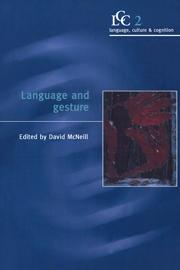Book contents
- Frontmatter
- Contents
- Acknowledgments
- Introduction
- Part 1 Gesture in action
- Part 2 Gesture in thought
- 7 Growth points in thinking-for-speaking
- 8 How representational gestures help speaking
- 9 Where do most spontaneous representational gestures actually occur with respect to speech?
- 10 Gesture production during stuttered speech: insights into the nature of gesture–speech integration
- 11 The role of gestures and other graded language forms in the grounding of reference in perception
- 12 Gesture and the transition from one- to two-word speech: when hand and mouth come together
- Part 3 Modeling gesture performance
- Part 4 From gesture to sign
- Index
12 - Gesture and the transition from one- to two-word speech: when hand and mouth come together
Published online by Cambridge University Press: 07 January 2010
- Frontmatter
- Contents
- Acknowledgments
- Introduction
- Part 1 Gesture in action
- Part 2 Gesture in thought
- 7 Growth points in thinking-for-speaking
- 8 How representational gestures help speaking
- 9 Where do most spontaneous representational gestures actually occur with respect to speech?
- 10 Gesture production during stuttered speech: insights into the nature of gesture–speech integration
- 11 The role of gestures and other graded language forms in the grounding of reference in perception
- 12 Gesture and the transition from one- to two-word speech: when hand and mouth come together
- Part 3 Modeling gesture performance
- Part 4 From gesture to sign
- Index
Summary
Introduction
Despite the fact that they are produced in different modalities, gesture and speech form a unified communication system in adults. To explore whether symbolic communicative gesture and speech form a single system in young children, three girls and three boys were observed longitudinally during the transition from one- to two-word speech. Initially, gesture tended to be produced without speech, and, on the rare occasions when it was combined with speech, that speech was meaningless and not synchronized with the accompanying gesture. The two characteristics that define integration in adult speakers – semantic coherence (combining gesture with meaningful and related speech) and temporal synchrony (producing gesture in synchrony with speech) – were found to emerge in the children's communications at the same moment and prior to the onset of two-word speech. The onset of gesture–speech integration thus occurs during the one-word period and before words are combined with other words.
Adults and children typically express their thoughts in speech, and, along with that speech, they spontaneously produce gestures. Despite the fact that they are produced in different modalities, gesture and speech deliver a coherent message to the listener (Alibali, Flevares & Goldin-Meadow 1997; Goldin-Meadow & Sandhofer 1999; Goldin-Meadow, Wein & Chang 1992; McNeill, Cassell & McCullough 1994) and thus can be said to form a single unified communication system (Goldin-Meadow 1997; Goldin-Meadow, Alibali & Church 1993; McNeill 1985, 1992).
- Type
- Chapter
- Information
- Language and Gesture , pp. 235 - 258Publisher: Cambridge University PressPrint publication year: 2000
- 113
- Cited by



